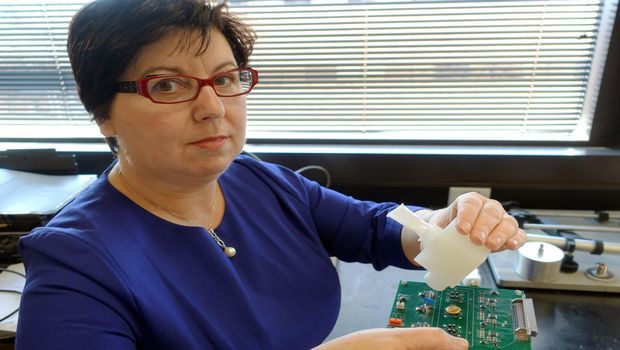Materials Scientist Invents Breath Monitor to Detect Flu
Perena Gouma, a professor in the Materials Science and Engineering Department at The University of Texas at Arlington, has published an article in the journal Sensors that describes her invention of a hand-held breath monitor that can potentially detect the flu virus.


Perena Gouma, a professor in the UTA Materials Science and Engineering Department. Courtesy of UT Arlington
Perena Gouma, a professor in the Materials Science and Engineering Department at The University of Texas at Arlington, has published an article in the journal Sensors that describes her invention of a hand-held breath monitor that can potentially detect the flu virus.
The article explains in-depth how the single-exhale sensing device works and the research involved in its creation, which was funded by the National Science Foundation through the Smart Connected Health program. Gouma's device is similar to the breathalyzers used by police officers when they suspect a driver of being under the influence of alcohol. A patient simply exhales into the device, which uses semiconductor sensors like those in a household carbon monoxide detector.
The difference is that these sensors are specific to the gas detected, yet still inexpensive, and can isolate biomarkers associated with the flu virus and indicate whether or not the patient has the flu. The device could eventually be available in drugstores so that people can be diagnosed earlier and take advantage of medicine used to treat the flu in its earliest stages. This device may help prevent flu epidemics from spreading, protecting both individuals as well as the public health.
Gouma and her team relied on existing medical literature to determine the quantities of known biomarkers present in a person's breath when afflicted with a particular disease, then applied that knowledge to find a combination of sensors for those biomarkers that is accurate for detecting the flu. For instance, people who suffer from asthma have increased nitric oxide concentration in their breath, and acetone is a known biomarker for diabetes and metabolic processes. When combined with a nitric oxide and an ammonia sensor, Gouma found that the breath monitor may detect the flu virus, possibly as well as tests done in a doctor's office.
"I think that technology like this is going to revolutionize personalized diagnostics. This will allow people to be proactive and catch illnesses early, and the technology can easily be used to detect other diseases, such as Ebola virus disease, simply by changing the sensors," said Gouma, who also is the lead scientist in the Institute for Predictive Performance Measurement at the UTA Research Institute.
"Before we applied nanotechnology to create this device, the only way to detect biomarkers in a person's breath was through very expensive, highly-technical equipment in a lab, operated by skilled personnel. Now, this technology could be used by ordinary people to quickly and accurately diagnose illness."
Stathis Meletis, chair of the Materials Science and Engineering Department, noted that Gouma's research shows how UTA's nanotechnology research can have a profound impact on health and the human condition in our communities, as outlined in the University's Strategic Plan 2020: Bold Solutions | Global Impact.
"Dr. Gouma's development of a portable, single-exhale device that can be used to detect diseases has implications far beyond the laboratory," Meletis said. "This shows the impact of nanotechnology on our everyday lives, and has potential for applications related to security and other important areas as well."
In addition to Gouma's research, UTA engineering faculty have applied nanotechnology to fighting cancer, increasing energy efficiency and detecting harmful substances, among other applications.
Gouma joined UTA in 2016 after spending 16 years at SUNY Stony Brook. She earned more than $6 million in research funding from federal and state agencies, such as the National Science Foundation, the Environmental Protection Agency and the Department of Defense. She is a member of the National Academy of Inventors, was a Fulbright Scholar and earned the prestigious Richard M. Fulrath Award from the American Ceramic Society.
Source: University of Texas at Arlington
Top 7 Infection Control Today Articles of 2024: Insights and Innovations
December 30th 2024From advanced sterilization methods to combating antimicrobial resistance, Infection Control Today’s top articles of 2024 delivered actionable strategies for safer healthcare environments and improved patient outcomes.
Revolutionizing Infection Prevention: How Fewer Hand Hygiene Observations Can Boost Patient Safety
December 23rd 2024Discover how reducing hand hygiene observations from 200 to 50 per unit monthly can optimize infection preventionists' time, enhance safety culture, and improve patient outcomes.
Redefining Competency: A Comprehensive Framework for Infection Preventionists
December 19th 2024Explore APIC’s groundbreaking framework for defining and documenting infection preventionist competency. Christine Zirges, DNP, ACNS-BC, CIC, FAPIC, shares insights on advancing professional growth, improving patient safety, and navigating regulatory challenges.
Addressing Post-COVID Challenges: The Urgent Need for Enhanced Hospital Reporting Metrics
December 18th 2024Explore why CMS must expand COVID-19, influenza, and RSV reporting to include hospital-onset infections, health care worker cases, and ER trends, driving proactive prevention and patient safety.